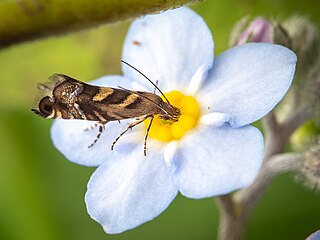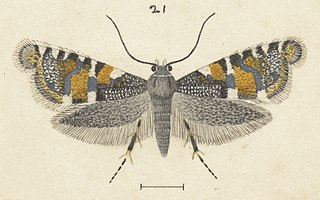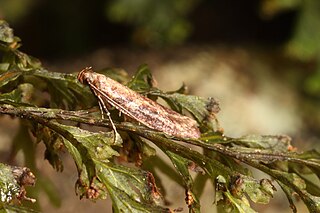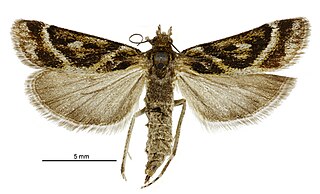
Acrocercops leucocyma, also known as the kauri leafminer, is a species of moth in the family Gracillariidae. It is endemic to New Zealand.

Izatha psychra is a species of moth in the family Oecophoridae. It is endemic to New Zealand. It is classified as Nationally Endangered by the Department of Conservation. In 2020 it was feared that this moth was extinct as a result of a fire at the Pukaki Scientific Reserve, the last known locality of this species. However a 2021 survey found I. psychra present in the small portion of the reserve that was not damaged by the fire.

Batrachedra tristicta is a species of moth in the family Batrachedridae. It is endemic to New Zealand and has been found in both the North and South Islands. The larvae feel on the flowers and seed heads of rushes in the genus Juncus. The adults of this species are on the wing in March.

Heterocrossa contactella is a species of moth in the family Carposinidae. It is endemic to New Zealand and can be observed in both the North and South Islands. The preferred habitat of this species is native forest and scrub, especially where Leptospermum shrubs are found. Adults are on the wing in December and January.

Heterocrossa epomiana is a species moth in the family Carposinidae. It is endemic to New Zealand and has been observed in Westland. Adults are on the wing in January. This species is visually very similar to H. gonosemana and to H. philpotti.

Heterocrossa exochana is a species of moth in the family Carposinidae. It is endemic to New Zealand and has been observed in the North and South Islands. The larvae of this species feed on the fruits of Muehlenbeckia species. The adult is on the wing from September until May and are attracted to light.

Heterocrossa iophaea is a species of moth in the family Carposinidae. It is endemic to New Zealand and has been observed in both the North and South Islands. This species inhabits native forest. The larvae feed on the seeds of the mataī tree, Prumnopitys taxifolia. Adults are on the wing from October to February. They are nocturnal and are attracted to light. During the day the adult moths rest on the trunks of trees or hide among the twigs and leaves on the ground.

Glyphipterix acronoma is a species of sedge moth in the genus Glyphipterix. It is endemic to New Zealand and is found in the North and South Islands. It's preferred habitat is open fields on mountain sides and adults are on the wing in December and January.

Glyphipterix tungella is a species of sedge moth in the genus Glyphipterix. It is endemic to New Zealand and is found throughout the country. Larvae mine the leaves of small sedges. Adults of this species are day flying and inhabit sheltered scrub or grassy areas and forest clearings.

Glyphipterix euastera is a species of sedge moth in the genus Glyphipterix. It is endemic to New Zealand. This species is classified as "At Risk, Naturally Uncommon" by the Department of Conservation.

Ichneutica omoplaca is a moth of the family Noctuidae. It is endemic to New Zealand. It is widespread from the Bay of Plenty in the North Island down to Southland in the South Island. Specimens have also been collected from the Auckland Islands. It lives in a variety of habitats including beech forest clearings and tussock grasslands. This species has been recorded that some of the larval hosts of this species include Poa cita, Dactylis glomerata and it has been reared on Plantago lanceolata. The larva is undescribed but pupae have been found in a pine plantation in soil under weeds. Adults of this species are on the wing from October to March. The adult moths are variable in appearance but the diagnostic feature is the pale ochreous to white colouring between the basal streak and the costa which contrasts with the ground colour of the forewing.

Ichneutica steropastis, or the flax notcher moth, is a species of moth in the family Noctuidae. It is endemic to New Zealand and can be found throughout the country from the Three Kings Islands to Stewart Island as well as in the Chatham Islands. The larvae of this species feed on a variety of native and introduced plants however the New Zealand flax is one of the more well known host plants for the larvae of this moth. The larvae are nocturnal, hiding away in the base of the plants and coming out to feed at night. They create a distinctive notch in the leaf when they feed. The adults of this species are on the wing from October to March. Although adult specimens of I. steropastis are relatively easy to recognise they might possibly be confused with I. inscripta, I. theobroma or with darker forms of I. arotis. However I. steropastis can be distinguished as it has a long dark basal forewing streak that these three species lack.

Stathmopoda skelloni, the yellow featherfoot, is a species of moth in the Stathmopodidae family. It is endemic to New Zealand and can be found throughout the country. This species inhabits native forest, coastal dunes and shrubland as well as cultivated gardens and orchards. The larvae of this species feed on a variety of plant species including agricultural crops such as kiwifruit and persimmons. The adult moths are on the wing from September until March and are nocturnal but are attracted to light.

Cadmogenes is a genus of moths of the family Plutellidae. It contains only one species, Cadmogenes literata, which is found in New Zealand. This species is endemic to New Zealand. It has been classified as "Not Threatened" by the Department of Conservation.

Culladia strophaea is a species of moth in the family Crambidae. It is endemic to New Zealand. The taxonomy of this species is currently uncertain.

Eudonia xysmatias is a moth in the family Crambidae. It was first described by Edward Meyrick in 1907. This species is endemic to New Zealand and has been observed and collected in Otago. This species inhabits wetlands. Adults are day flying and are on the wing in December and January.

Elachista helonoma is a species of moth in the family Elachistidae. This species is endemic to New Zealand. It is classified as "At Risk, Relict'" by the Department of Conservation.
Zelleria sphenota is a species of moth in the family Yponomeutidae. This species is endemic to New Zealand. It is classified as "At Risk, Declining'" by the Department of Conservation.

Asaphodes chlorocapna is a species of moth in the family Geometridae. This species is endemic to New Zealand and can only be found in the Chatham Islands. The larvae of this species consume the leaves of Muehlenbeckia plants. Adults are on the wing in January. This species is classified as "At Risk, Relict'" by the Department of Conservation.

Tingena loxotis is a species of moth in the family Oecophoridae. This species is endemic to New Zealand and is found in the North Island. This species is found in gardens and are known to enter houses. Adults are on the wing in December and January. It is classified as "Data Deficient" by the Department of Conservation.






















